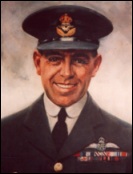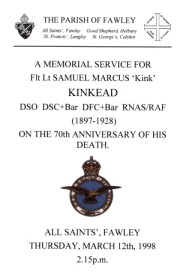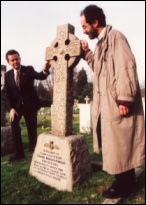Appreciation by Julian Lewis MP
70th Anniversary Memorial Service
All Saints' Church, Fawley, 12 March 1998
 To give an appreciation of the life of a famous man seventy years after his untimely death, one can rely on three things: the public record, the private record and the personal record.
To give an appreciation of the life of a famous man seventy years after his untimely death, one can rely on three things: the public record, the private record and the personal record.
The public record states that 'Kink' Kinkead was born on 26 February 1897, of an Irish father and Scottish mother, out in Johannesburg. He volunteered whilst a teenager. He was eighteen when he signed up to the Royal Naval Air Service in September 1915. He learned to fly at Eastbourne between October and December 1915 and he served in the Dardanelles until November 1916 when, after a severe attack of malaria, he was invalided home.
His real glory days began from September 1917, when he was seconded to No.1 Squadron, Royal Naval Air Service, based at Dover and Dunkirk. It became, of course, 201 Squadron RAF, when the RAF was formed out of the merging of the Royal Naval Air Service and the Royal Flying Corps on 1 April 1918.
He then gained a string of gallantry awards: the DSC, a Bar, the DFC, a Bar. The citations, on the public record, describe him as:
"A fine example to other pilots", with "skill and determination", "skill and courage", "gallantry and skill". "An exceptionally good pilot and a clever and plucky fighter [who] has performed very fine work, both on offensive patrols and on low flying missions ... A bold and daring airman."
So much for the public reports – but the Confidential ones on his Service Record (which he never saw) are no less outstanding:
"An excellent officer. Keen, plucky, hard-working, and thoroughly reliable. Very unassuming. One of the best type of successful Service pilots ... Exceptionally efficient ... has personally led 68 bombing attacks ... with greatest determination and devotion to duty. Brilliant pilot ... excellent in every respect ... with a great number of aerial victories to his credit."
 Indeed, during the First World War, he shot down at least 30 enemy aircraft, and up to ten more in Russia – when he won the DSO in the field with the Allied intervention force, fighting against the Bolsheviks. In fact, what was so remarkable about his gallantry was not his skill – considerable though it was – in outwitting enemy pilots, but his raw courage in developing a technique whereby he would take on and disperse huge numbers of ground troops by persistently diving down and firing and bombing, irrespective of the fact that, if he could hit them, they most certainly could hit him.
Indeed, during the First World War, he shot down at least 30 enemy aircraft, and up to ten more in Russia – when he won the DSO in the field with the Allied intervention force, fighting against the Bolsheviks. In fact, what was so remarkable about his gallantry was not his skill – considerable though it was – in outwitting enemy pilots, but his raw courage in developing a technique whereby he would take on and disperse huge numbers of ground troops by persistently diving down and firing and bombing, irrespective of the fact that, if he could hit them, they most certainly could hit him.
The early and mid-1920s saw him as an instructor at Cranwell and then serving in Iraq where, on one notable occasion, he landed, as did another pilot, to rescue the crew of a downed RAF plane – taking off with the bullets of hostile tribesmen whistling around their ears. After organising part of the flight between Cairo and the Cape and back in 1926, he was posted to the RAF High Speed Flight.
As a member of the victorious Schneider Trophy Team at Venice in 1927, he was described as winning the admiration of all spectators. This is what one account said:
"So evenly did he make the turns and so exactly did he maintain his height of a few feet from the water, that it appeared as if his machine were running on rails. It was discovered after the race that a serious defect had developed in his machine and that, if he had abandoned the race an instant later than he did, a disaster would have been inevitable."
Undeterred by this extremely close shave, he then set himself the task of regaining the World Speed Record, in a Supermarine S.5 – a direct forerunner, as we know, of the Spitfire. He was with that gallant troupe of people who were pushing the technology to its limits. The Schneider Trophy winning speeds had risen from 107 miles per hour immediately after the First World War, to 280 miles per hour in just nine years.
 But, on 12 March 1928, not even Kink's legendary skill and luck could save him. The machine suddenly dived vertically into the sea, its engine roaring. Whether he was overcome by fumes, or whether the machine suffered a mechanical failure, was never established; but Kink was killed instantly.
But, on 12 March 1928, not even Kink's legendary skill and luck could save him. The machine suddenly dived vertically into the sea, its engine roaring. Whether he was overcome by fumes, or whether the machine suffered a mechanical failure, was never established; but Kink was killed instantly.
He was not the first member of his family to die in this way: his elder brother Thompson died in a crash in 1917. Such pioneers laid their lives on the line so often that this outcome was always on the cards.
Yet, even in a galaxy of courageous fliers, Kink was outstanding, and it is fitting to end with the personal record – to leave the last word to another gallant air ace of World War One, Ira 'Taffy' Jones, who summed him up in these words in his memoirs, An Air Fighter's Scrap-book, published in 1938, a decade after Kink died:–
"When Kinkead, still a flight lieutenant, went deep into the Solent in his Supermarine S.5 late in the afternoon of March 12, 1928, when attempting to beat the world's speed record, the Royal Air Force lost, without doubt, its finest junior officer.
"He was remarkably brave, a brilliant pilot, ideal leader, and straight as a die in all his dealings with his juniors and seniors. He was modest in the extreme and such was his tremendous personality that everyone who came in close contact with him looked upon him as someone apart from his fellow-officers. Each thought that his friendship was theirs alone: something so precious that others could not possibly have it.
"I think it is quite unnecessary to say any more than this about the award of decorations and promotion: Kinkead did not receive any decorations or promotion for his magnificent peace-time work. He was junior to officers who were unworthy of cleaning his shoes.
"Many brave airmen had gone before Kinkead, and I feel sure that Valhalla was well lit up on the night of March 12, 1928."
* * * *
[Julian's biography of Samuel Kinkead, RACING ACE, was published in March 2011. For full details, click here and here.]
[For Early Day Motion on Samuel Kinkead, click here
For more information on Samuel Kinkead, click here
For later developments, click here, here and here]